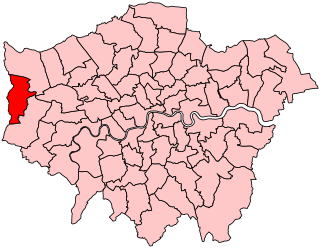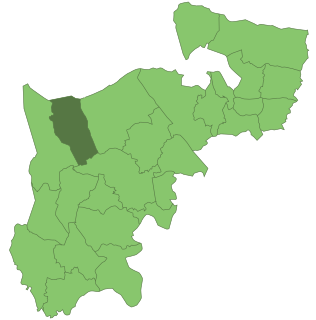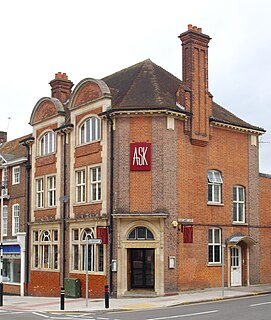
Ickenham is an area centred on an old village in Greater London, part of the London Borough of Hillingdon.

Ruislip is an area in West London, England, which is part of the London Borough of Hillingdon. Ruislip lies 13.8 miles (22.2 km) west-north-west of Charing Cross, London.

Uxbridge is a town in west London, England, and the administrative headquarters of the London Borough of Hillingdon. 15.4 miles (24.8 km) west-northwest of Charing Cross, it is one of the major metropolitan centres identified in the London Plan. Uxbridge historically formed part of the parish of Hillingdon in the county of Middlesex, and was a significant local commercial centre from an early time. As part of the suburban growth of London in the 20th century it expanded and increased in population, becoming a municipal borough in 1955, and has formed part of Greater London since 1965. It is a significant retail and commercial centre, and is the location of Brunel University and the Uxbridge campus of Buckinghamshire New University. The town is close to the boundary with Buckinghamshire, which is locally the River Colne.

Eastcote is an area established around an old village in the west of Greater London and is part of the London Borough of Hillingdon.

RAF Uxbridge was a Royal Air Force (RAF) station in Uxbridge, within the London Borough of Hillingdon, occupying a 44.6-hectare (110-acre) site that originally belonged to the Hillingdon House estate. The British Government purchased the estate in 1915, three years before the founding of the RAF. Until the outbreak of the Second World War in 1939, the station was open to the public.

Hillingdon is an area within the London Borough of Hillingdon, situated 14.2 miles (22.8 km) west of Charing Cross. It was an ancient parish in the county of Middlesex that originally included the market town of Uxbridge. During the 1920s Hillingdon experienced a rapid increase in population and was absorbed by Uxbridge Urban District in 1929. It has formed part of Greater London since 1965.

Uxbridge was a borough constituency represented by one Member of Parliament (MP) in the House of Commons of the UK Parliament, 1885—2010. Its MPs elected were the Conservative Party's candidates for 107 years and the Labour Party's candidates for 18 years. The closing 40 years of the seat's history saw elections won by a Conservative candidate — in 1997 on a very marginal majority in relative terms.

Hillingdon Hospital is an NHS hospital, located in Pield Heath Road, Hillingdon, Greater London. It is one of only two hospitals run by the Hillingdon Hospitals NHS Foundation Trust, the other being Mount Vernon Hospital.

Ruislip-Northwood was an urban district in west Middlesex, England, from 1904 to 1965. From its inception Ruislip-Northwood fell within the Metropolitan Police District and from 1933 it was part of the London Passenger Transport Area.

Ruislip Lido is a reservoir and artificial beach in Ruislip, within the London Borough of Hillingdon, England, situated between Ruislip Common, Ruislip Woods, and Poors Field.

Mount Vernon Hospital is located in Northwood. It is one of two hospitals run by The Hillingdon Hospitals NHS Foundation Trust.

The Hillingdon Sports and Leisure Complex is a leisure centre in Uxbridge, operated by Fusion Lifestyle on behalf of the London Borough of Hillingdon. The complex is centred on the Grade II listed outdoor swimming pool, known as Uxbridge Lido until 2010, when the newly built centre and refurbished pool were opened. A new indoor pool was built beside the lido as part of the redevelopment works, opening in February 2010, followed a day later by the outdoor pool.

Ruislip Woods is a Site of Special Scientific Interest and national nature reserve covering 726 acres (294 ha) in Ruislip in the London Borough of Hillingdon. The woods became the first national nature reserve in an urban area of England in May 1997, receiving the Green Flag Award in 2006. Ruislip Local Nature Reserve at TQ 090 899 is part of the national nature reserve.

RAF Eastcote, also known over time as RAF Lime Grove, HMS Pembroke V and Outstation Eastcote, was a Ministry of Defence site in Eastcote, within the London Borough of Hillingdon.

Highgrove House, also known as High Grove House or High Grove, is a Grade II listed mansion in the suburban area of Ruislip, within the London Borough of Hillingdon. Originally built in 1750 by the Reverend John Lidgould, the house was rebuilt in 1881 by Sir Hugh Hume-Campbell following a catastrophic fire. Along with Haydon Hall and Eastcote House, Highgrove was one of the three main houses of Eastcote and eventually became a residential hostel for homeless families, run by the local council from the 1960s until 2007. An area of the estate was sold to the local council in 1935 by the then-owner Eleanor Warrender to become what is now Warrender Park. In 1975, the house was granted Grade II listed status on account of its special architectural character.

Eastcote House Gardens is an area of public parkland in Eastcote, within the London Borough of Hillingdon. The site covers 3.63 hectares and incorporates the walled garden, dovecote and coach house of Eastcote House. The house was demolished in 1964 by the Ruislip-Northwood Urban District Council (RNUDC), the predecessor of the London Borough of Hillingdon. At the public's request, the garden and outbuildings were retained and are now maintained by a group of volunteers, the Friends of Eastcote House Gardens, in partnership with the local authority.

Hayes Cottage Hospital was a healthcare facility in Hayes, London






















